Sourdough, how I love thee! So many people have jumped on the sourdough bandwagon in the last few years. Have you? Do you find it complicated? Maybe annoying? Possibly wasteful to keep a sourdough starter alive? LET ME HELP! I’ll teach you how easy it is to keep a sourdough starter. NO daily feedings or wasteful discards!
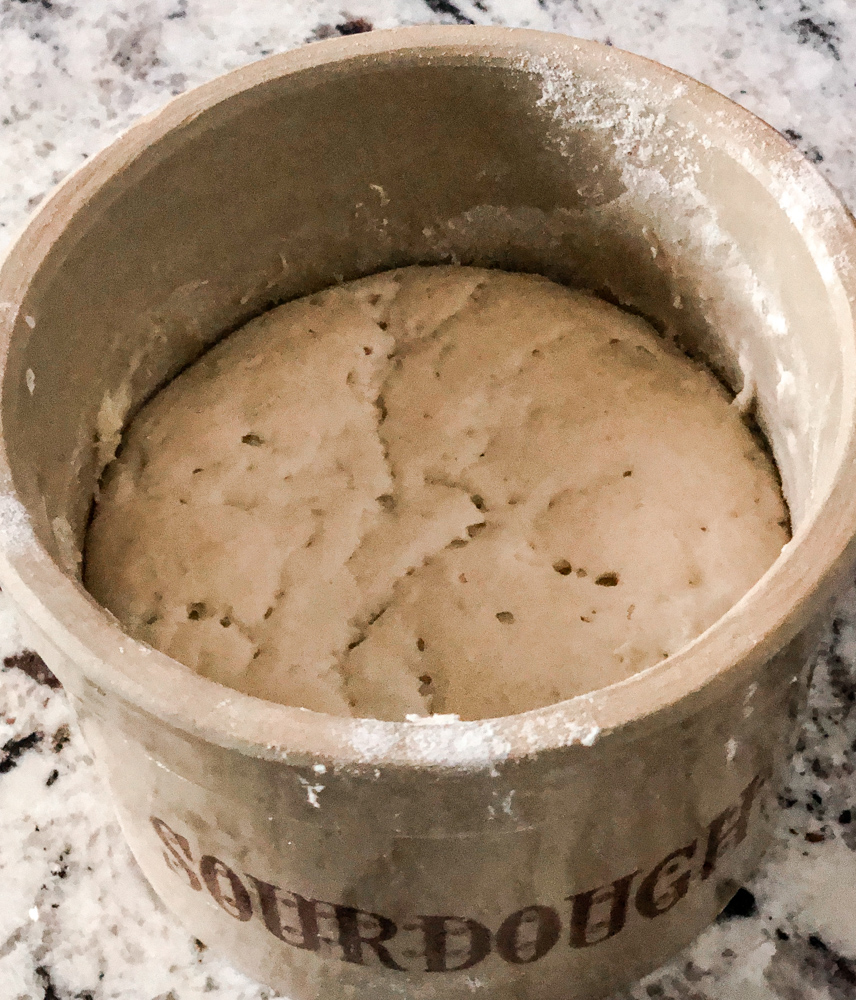
This post may contain Amazon Affiliate Links, which means I make a small commission at no extra cost to you. See my full disclosure at homemakingwithoutfear.com. Furthermore as an Amazon Associate, I may earn from qualifying purchases.
A healthy sourdough starter is necessary to get lovely risen breads without commercial yeasts. But sometimes having a sourdough starter is like taking care of another child!
Oh the constant feedings and managing discards – many of us just don’t have time for that. . .

I really enjoy baking and keeping my homemade starter going but I don’t/can’t bake daily AND I find the daily feeds and discards to be wasteful.
Even though sourdough is a healthier bread option it is still a calorie-dense complex carbohydrate. . .We just can’t don’t eat that much bread in a week.
Sooooo……..
I went on the hunt for an easier option to keeping a starter alive and also quickly active and bubbly when I DO need it to be.

What is the answer, you ask?
DRY Sourdough Starter!!!
Well not completely dry but “drier” than the traditional starter.

Just WATCH how easy it really is to keep a Dry Sourdough Starter –
How does the “Dry” Sourdough Starter work?

OK friends, if you are unfamiliar with sourdough starter – here are the basics:
- A sourdough starter is made out of flour, water and “captured” naturally occurring yeasts.
- To keep a sourdough starter “alive”, you typically remove a portion of the starter every day and “feed” what is left a mixture of flour and water.
- Sourdough starters may also be known as a “mother dough” because you need just a lil’ but of it in a recipe to cause a dough to rise.
- An active starter may also be called a “levain” because it acts to leaven or rise and lighten bread dough.
Natural yeasts in the sourdough stater feed off of the sugars in the flour, giving of carbon dioxide that causes the starter to bubble and expand.
Just a bit of this starter in a bread recipe causes the bread to rise WITHOUT the addition of commercially formulated yeasts. (aka dry active yeast or instant yeast)

After all. . .
A little leaven leavens the whole lump!
Galatians 5:9
Just a small piece of starter (about a tablespoon) is needed to create an active, bubbly flour/water mixture.
So what is the deal with a “DRY” sourdough starter and what makes it easy to keep?
OK so a traditional starter is fed flour & water at a ratio of 1:1. . .
For example if you are going to feed a traditional starter, you would remove and toss (or use) all but 1/2 cup or so. You would then feed what is left, equal parts (1/2 cup of flour and 1/2 cup of water).
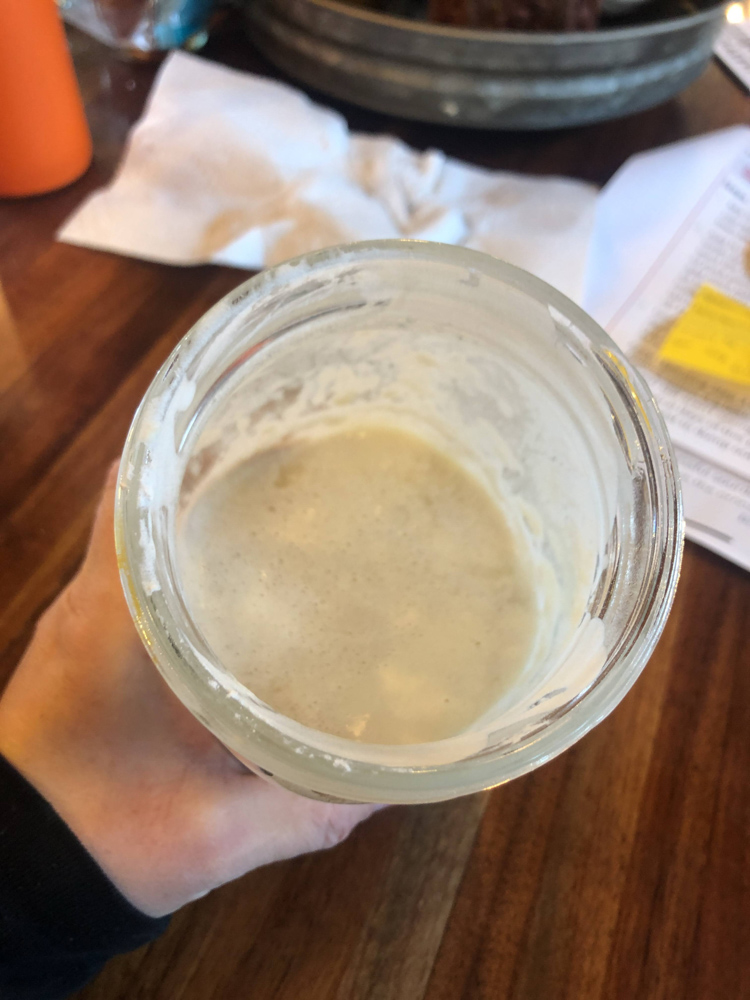
This 1:1 ratio results in a starter that is the consistency of pancake batter.
You would then let the starter sit out on the counter (room temperature) and ferment or become active.
The next day you would have to discard (or use) all but 1/2 cup or so and repeat the feeding process. . . on an on day after day this process continues.
You can see how this would become repetitive and demanding for many of us during this busy day in age. . . honestly I just forget mine often.
And what about when you go on vacation?
And what about all the discarded starter? What do you do with that?
You can certainly use the daily discarded starter to make all kinds of yummy things – pancakes, crapes, cookies and even brownies. My problem is I could never make all these things daily because I would EAT all those things daily and while yummy and relatively healthy – NOT so good for my waistline. . .
A DRY starter on the other hand is fed at a 2:1 ratio. That is 2 parts flour to 1 part water.
This results in a sourdough starter that is the consistency more like a ball of sticky bread dough. The greater flour content gives the starter more “food” in the form of sugars to live on. Therefore it can go longer between feedings.
You DO NOT have to feed this dry starter daily. Therefore you DO NOT have to discard either.
ALSO – you keep this starter in the refrigerator to maintain freshness and longevity of yeasts, not on counter at room temperature. If you choose to keep it on the counter you will have to feed it more often to keep it from going bad!
So How do I convert my EXISTING wet starter to the DRY starter?
You are in LUCK. It is super easy to change over to a dry sourdough method.
Simply take 30 grams (approx 1 Tbsp) of your current sourdough starter. Feed it 100 grams of all purpose (AP) flour and 50 grams of warm water.

This mixture will resemble a soft bread dough. Mix it with a fork then remove from the container and knead it a few times.
This will speed up yeast introduction and production as the starter collects natural yeasts in it’s environment (in your kitchen and even on your hands!)
Science is so COOL!!!

After kneading your starter, pop it into a clean crock or glass container, cover lightly and let it activate at warm room temperature until bubbly (about 4-12 hours depending on maturity of starter and temperature in your kitchen).
AFTER the dry starter is bubbly, risen and activated – place a snug fitting lid on it and store in REFRIGERATOR until you want to bake bread.
NOTE: YOU DO NEED A MATURE ACTIVE, PROVEN STARTER BEFORE YOU CONVERT TO THIS METHOD. MAKE SURE IF YOUR STARTER IS BRAND NEW (YOUNG) THAT YOU LET IT BECOME VERY ACTIVE BEFORE YOU CONVERT IT TO A DRY STARTER AND KEEP IT IN THE FRIDGE.
How this easy sourdough starter method actually works in baking
So your DRY sourdough starter is kept in the fridge. How do you bake bread with it?
Well, you simply take a small piece of your refrigerated starter and activate it, creating what is called a Levain.

NOTE: I prefer to weigh rather than measure when making sourdough because it is more accurate. Think about it, my estimate of full tablespoon may be different than yours! Kitchen scales are also very inexpensive.
Weigh a large tablespoon or about 30 grams of starter and place it in a clean mixing bowl. Feed it with 100 grams of warm water and 80 grams of all purpose flour.
The consistency of this mixture will resemble cake batter. Very similar to consistency of your traditional wet sourdough starter. (maybe a bit thicker)

Let the mixture activate by sitting lightly covered at room temperature (4-12 hours) and use it in your recipe just like you normally would. This mixture which is the FIRST step of your bread baking is called a Levain.
Levain is a French word meaning “to rise” and sounds a lot like the English word leaven which also means to rise, modify or transform. Levain REFERS to a portion of the original “mother starter” that has been recently fed and is ready to be used in a recipe that calls for a “active starter” .
The Levain will then be used as the active starter in any recipe calling for it. It will lighten and help your dough to rise just like a regular WET sourdough starter would.
YES you are correct there is a bit of an extra step when you want to bake because you have to feed and create your Levain FIRST. But you would have to feed and activate a traditionally kept starter too – right!?
When do I have to feed a dry starter?
Feed it only when you are down to a large tablespoon (about 30 grams) remaining in your mother starter. Feed at the 2:1 ratio. That is 2 parts flour and 1 part water which equates to about 100 grams of flour (approx 2 tablespoons) and 50 grams (approx 1 tablespoon) of warm water (approximately 80-85 degrees F)!
Mix, knead it, put it back into your container, let it rest at warm room temperature until bubbly (about 4-12 hours). Then pop it back in the fridge for storage.
For most recipes calling for 1/2 cup to 1 cup of starter, you can make about 4-5 loaves of bread from the one mother starter before you have to feed it again!
This may take some people who make bread daily a week before feeding is necessary. For others this may take a couple months. Either way, there is much less time and resources involved in keeping a starter using the dry method.
The beauty of a dry sourdough starter is that it doesn’t really matter how long between feedings as long as you always leave 30 grams or more when feeding.
What does the process of preparing to bake bread look like with a easy to keep dry sourdough starter?
Step 1: Create your Levain

Weigh and remove 30gm of starter from the cold mother starter. Place in a pint glass jar or small bowl.

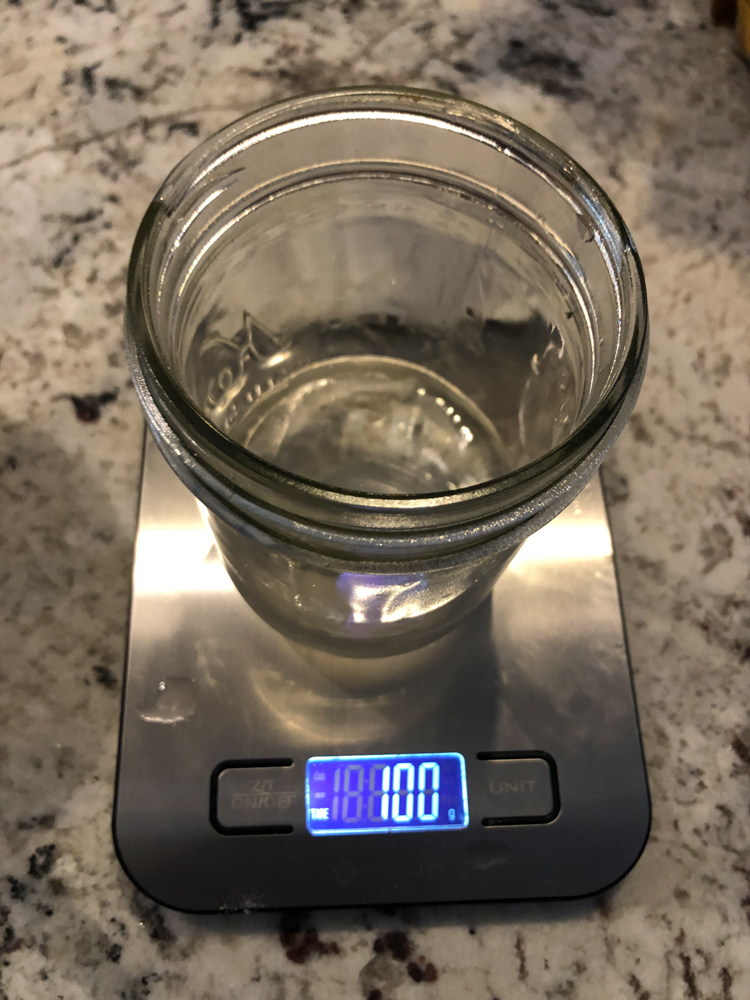
Add 100 grams of warm water and mix well with a fork.


Add 80 grams of all purpose flour and mix well with your fork. This will yield about 1 cup of (Levain) active starter total.

Step 2: Let the Levain activate (4-12 hours)

Cover lightly and let the mixed Levain ferment (become bubbly and active).

Step 3: Use the Levain as the active starter in any sourdough recipe

You can use Levain as you normally would in place of “active starter” in any recipe that calls for it.
Step 4: Bake beautifully risen sourdough breads as you normally would.

I love to make anything from a artisan sourdough boule to everything bagels with the same sourdough recipe!
Step 5: ENJOY!

IN SUMMARY: FEEDING & USING A DRY SOURDOUGH STARTER
FEED a dry sourdough mother starter at a 2:1 ratio when you have 30 grams left.
- Feed 30 grams of starter with 100 grams of AP flour and 50 grams of warm water (consistency of a soft bread dough- stir then knead by hand)
- Let activate and become bubbly at warm room temperature. For 4-12 hours. Store in refrigerator. Feed again when you have 30 grams left.
Make a LEVAIN when you are ready to bake bread. Feed a portion of the mother starter with less flour and more water to create an active starter.
- Feed 30 grams of cold mother starter with 80 grams of AP flour and 100 grams of warm water (consistency of cake frosting – stir it with a fork)
- Let activate and become bubbly at warm room temperature. For 4-12 hours. Use in any recipe calling for active sourdough starter.
Don’t have an easy sourdough starter? Get a start from a friend – OR – Make your own starter from scratch.
I love the idea of getting a bit of starter from a friend or family member, feeding it and making the starter live on.
A sourdough starter can live for years if properly cared for! Some claim they have starters that are 100 years old. Many are handed down through the generation. How cool is that!?

It is said that each starter may have it’s own unique flavor and level of tang. Young starters are said to have a different flavor than starters that have been fed and cultured for years.
If you can’t get a piece of starter, you can make your own starter by simple mixing four and water and letting it sit and ferment, feeding it and caring for it as it cultures yeast for 7-10 days.
Yeast is a normal, harmless fungus that lives naturally in the environment of our kitchens, utensils and even on our hands. As it cultures or grows in the flour/water mixture, feeding on sugars it gives off alcohol and carbon dioxide as byproducts. You can see this activity as BUBBLES in the sourdough starter – we call this bubbly mixture an “active” starter.
Here is one of my FAVORITE tutorials for making your own easy to keep sourdough starter – From Scratch.
Read about it HERE:
How to Creat an Einkorn Sourdough Starter – Jovial Foods
Watch it HERE:
Get my FAVORITE NO-Knead Sourdough Bread Recipe!
Sourdough Problems? Want to learn to make better sourdough bread? (checkout this super helpful video from Shaye Elliott of theelliotthomestead.com)
Hey Sweet Friends,
Thanks for stopping by to learn how EASY it is to keep a sourdough starter. I know we are all incredibly busy and often distracted in this crazy thing called life. The last thing we need is another to-do added to the long list. We sure don’t need the guilt of killing another sourdough starter too! (Hahaha). . . Let’s simplify shall we??? Hope you enjoy this dry starter method. Make my simple sourdough bread recipe and let me know how you like it. COMMENT and leave sourdough questions below!

Shop this Post
This post may contain Amazon Affiliate Links, which means I make a small commission at no extra cost to you. See my full disclosure at homemakingwithoutfear.com. Furthermore as an Amazon Associate, I may earn from qualifying purchases.

Dry Sourdough Starter
A dry sourodugh starter is much easier to keep than a traditional wet starter fed at a 1:1 flour to water ratio. When fed at a 2:1 ratio a dry starter can be activated then kept in a refrigerator until ready to feed again. Bake approximately 5 loaves of bread with this one refrigerated dry starter before feeding is needed again. NO daily feeds and NO wasteful discards. How about that!?
Ingredients
- 30 grams regular sourdough starter (doesn't have to be active)
- 100 grams of All Purpose Flour
- 50 grams of warm water
Instructions
- Using a kitchen scale, simply take 30 grams (approx 1 Tbsp) of your current sourdough starter and place it in a clean glass or crock.
- Using a fork, mix the starter with 50 grams of warm water and 100 grams of all purpose (AP) flour. The starter will be the consistency of a soft bread dough.
- Remove the starter ball from the mixing bowl and knead it with your hands for a few minutes to introduce natural yeasts to your starter.
- Place the dry sourdough starter back into a clean glass or crock.
- Cover lightly with paper towel or loose fitting lid.
- Let sit at out at warm room temperature until active and bubbly. (approximately 4-12 hours depending on maturity of starter and temperature of room).
- After the dry starter has become active, place lid on container and store it in the refigerator. This is your dry "mother starter".
- When ready to bake bread, remove 30 grams of cold starter and use it to form a active, bubbly Levain.
You are in LUCK. It is super easy to change over to a dry sourdough method.
The Levain will be used in ANY sourdough recipe in place of "active sourdough starter".
To make a Levain: Mix 30 grams of refrigerated mother starter with 100grams of warm water and 80 grams of all purpose flour to the consistency of pancake batter. Allow it to sit at room temperature until active an bubbly. (4-12 hours) Then proceed with mixing your sourdough recipe as you normally would.
Pin it for Later




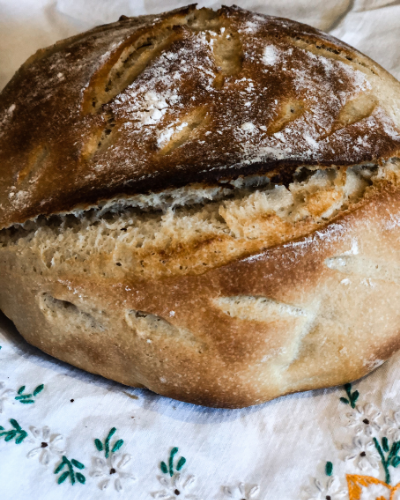





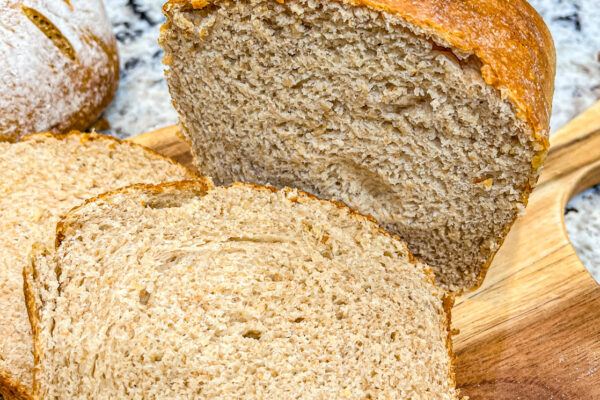


i cannot wait to try this! i just finished activating a new “wet” batch. if i am successful at my conversion, i’m gonna have alot of starter to share!